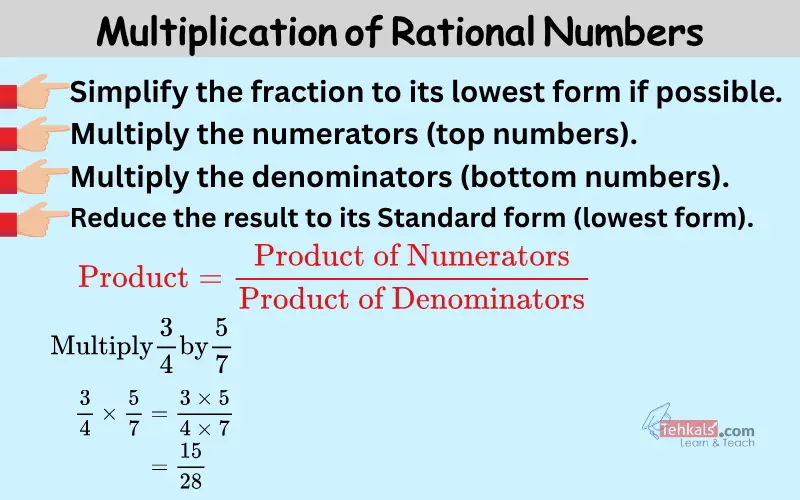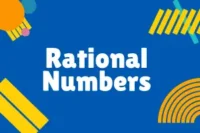Multiplying Rational Numbers – Rules, Real Life Examples, and Practice Questions
Published: 29 Oct 2025
Multiplying rational numbers is the process of finding the product of two or more numbers in the form $\dfrac{p}{q}$ where $q \neq 0$. These numbers can be fractions, integers, mixed numbers, or decimals.
In this guide, you will learn how to multiply rational numbers, when to simplify or cross-cancel, and see clear examples for mixed numbers, negatives, decimals, and more. You will be surprised how simple multiplying rational numbers can be once you see it step by step.
Student Learning Outcomes
By the end of this guide on multiplication of rational numbers, you will be able to:
- Multiply any rational numbers (fractions, integers, mixed numbers, decimals).
- Use cross cancellation / butterfly method to simplify before multiplying.
- Apply sign rules for negatives and convert between mixed/decimal/fraction forms.
- Solve multi-factor multiplication problems and check your answers.
How to Multiply Rational Numbers
To multiply rational numbers, follow these rules:
- Simplify the fraction to its lowest form if possible.
- Multiply the numerators (top numbers).
- Multiply the denominators (bottom numbers).
- Reduce the result to its Standard form (lowest form).
General Form:
The general form for Multiplication of Rational Numbers is:
$
\text{Product} = \dfrac{\text{Product of Numerators}}{\text{Product of Denominators}}
$
Product of Two Rational Numbers Formula
If $\dfrac{a}{b} \text{and} \dfrac{c}{d}$ are two rational numbers, then Product of Two Rational Numbers Formula is:
$
\dfrac{a}{b} \times \dfrac{c}{d}=\dfrac{a \times c}{b \times d}
$
Example
Multiply $\dfrac{3}{4} \text{by} \dfrac{5}{7}$
Solution
$
\begin{aligned}
\dfrac{3}{4} \times \dfrac{5}{7}
&= \dfrac{3 \times 5}{4 \times 7} \\
&= \dfrac{15}{28}
\end{aligned}
$

Methods of Multiplying Rational Numbers
Rational numbers can be multiplied in different ways depending on the numbers involved.
1. Simple Multiplication (No Cancellation)
When there’s no common factor between any numerator and denominator, simply multiply the numerators and denominators.
- Example # 1
$ \dfrac{3}{4} \times \dfrac{5}{6} = \dfrac{15}{24} $ - Example # 2
$
\dfrac{7}{4} \times \dfrac{7}{9} = \dfrac{49}{36}
$
Question: A rectangle has length $\dfrac{3}{5}$ m and width $\dfrac{2}{7}$ m. Find its area.
Solution:
$
\begin{aligned}
\dfrac{3}{5} \times \dfrac{2}{7}
&= \dfrac{3 \times 2}{5 \times 7} \\
&= \dfrac{6}{35}\ \text{m}^2
\end{aligned}
$
2. Simplifying Rational Numbers (Fractions) Before Multiplying
- Look at each fraction (top and bottom) separately.
- If they have a common factor, divide both by that number.
- Then multiply
General Form:
$
\dfrac{a}{b} \times \dfrac{c}{d}
$
- If $a$ and $b$ have a common factor, simplify.
- If $c$ and $d$ have a common factor, simplify.
Example # 1:
$
\begin{aligned}
\dfrac{36}{40} \times \dfrac{3}{5}
& = \dfrac{\cancel{36}^{9}}{\cancel{40}^{10}} \times \dfrac{3}{5} \\
& = \dfrac{9}{10} \times \dfrac{3}{5} \\
& = \dfrac{27}{50}
\end{aligned}
$
Example # 2:
$
\begin{aligned}
\dfrac{36}{4} \times \dfrac{7}{28}
& = \dfrac{\cancel{36}^{9}}{\cancel{4}^{1}} \times \dfrac{\cancel{7}^{1}}{\cancel{28}^{4}} \\
& = \dfrac{9}{1} \times \dfrac{1}{4} \\
& = \dfrac{9}{4}
\end{aligned}
$
Question: A piece of cloth is $ \dfrac{36}{40} $ m long. If each length is scaled by $ \dfrac{3}{5} $, what is the new length?
Solution:
$
\begin{aligned}
\dfrac{36}{40} \times \dfrac{3}{5}
&= \dfrac{\cancel{\color{red}{36}}^{9}}{\cancel{\color{red}{40}}^{10}} \times \dfrac{3}{5}\\
&= \dfrac{9}{10} \times \dfrac{3}{5} \\
&= \dfrac{9 \times 3}{10 \times 5} \\
&= \dfrac{27}{50}\ \text{m}
\end{aligned}
$
3. Cross Cancellation (Rational Numbers/ Fractions)
- Look across the fractions (numerator of one and denominator of the other).
- If they have a common factor, divide both by that number.
- Then multiply
General Form:
$
\dfrac{a}{b} \times \dfrac{c}{d}
$
- If $a$ and $d$ have a common factor, simplify.
- If $b$ and $c$ have a common factor, simplify.
Example:
$
\begin{aligned}
\dfrac{3}{35} \times \dfrac{25}{7}
&= \dfrac{3}{\cancel{35}^{7}} \times \dfrac{\cancel{25}^{5}}{7} \\
&= \dfrac{3}{7} \times \dfrac{5}{7} \\
&= \dfrac{15}{49}
\end{aligned}
$
Question: A rectangular garden has sides $ \dfrac{9}{10} $ m and $ \dfrac{5}{6} $ m. Find its area.
Solution:
$
\begin{aligned}
\dfrac{9}{10} \times \dfrac{5}{6}
&= \dfrac{\cancel{\color{red}{9}}^{3}}{\cancel{\color{red}{10}}^{2}} \times \dfrac{\cancel{\color{red}{5}}^{1}}{\cancel{\color{red}{6}}^{2}} \\
&= \dfrac{3}{2} \times \dfrac{1}{2} \\
&= \dfrac{3}{4}\ \text{m}^2
\end{aligned}
$
Cross Cancellation is also called Butterfly method.
What is the Butterfly Method? 🦋
- The Butterfly Method is a simple, visual way to perform cross cancellation when multiplying fractions (rational numbers).
- You cancel common factors diagonally — the crossing lines look like the wings of a butterfly, that is why it is called Butterfly Method.
$
\dfrac{a}{b} \times \dfrac{c}{d}
$
Example:
$
\begin{aligned}
\dfrac{6}{16} \times \dfrac{4}{9}
&= \dfrac{\cancel{6}^{2}}{\cancel{16}^{4}} \times \dfrac{\cancel{4}^{1}}{\cancel{9}^{3}} \\
&= \dfrac{2}{4} \times \dfrac{1}{3} \\
&= \dfrac{\cancel{2}^1}{\cancel{4}^2} \times \dfrac{1}{3} \\
&= \dfrac{1}{2} \times \dfrac{1}{3} \\
&= \dfrac{1}{6}
\end{aligned}
$

Question: A train travels $ \dfrac{6}{15} $ km in 1 minute. If it continues at the same speed, how far will it travel in $ \dfrac{5}{18} $ minutes?
Solution:
$
\begin{aligned}
\dfrac{6}{15} \times \dfrac{5}{18}
&= \dfrac{\cancel{\color{red}{6}}^{1}}{\cancel{\color{red}{15}}^{3}} \times \dfrac{\cancel{\color{red}{5}}^{1}}{\cancel{\color{red}{18}}^{3}} \\
&= \dfrac{1}{3} \times \dfrac{1}{3} \\
&= \dfrac{1 \times 1}{3 \times 3} \\
&= \dfrac{1}{9}\ \text{km}
\end{aligned}
$
4. Multiplying Negative Rational Numbers
- To multiply negative rational numbers, follow integers sign rules:
Negative × Negative = Positive
Positive × Negative = Negative - Then multiply
a) Both are Negative Rational Numbers
Example:
$ \dfrac{-7}{8} \times \dfrac{-3}{5} = \dfrac{21}{40} $
b) One Negative, One Positive Rational Number
Example:
$
\dfrac{-7}{8} \times \dfrac{3}{5} = \dfrac{-21}{40}
$
Question: The company lost $ \dfrac{2}{7} $ million dollars each month for 6 months. Find the total loss.
Solution:
$
\begin{aligned}
6 \times \left(-\dfrac{2}{7}\right)
&= \dfrac{6}{1} \times \left(-\dfrac{2}{7}\right) \\
&= -\dfrac{12}{7} \\
&= -1\dfrac{5}{7}\
\end{aligned}
$
So, the company’s total loss is $1\dfrac{5}{7}\ \text{million dollars}$
5. Multiplying Rational and Whole (integers) Number
- To multiply rational numbers and whole numbers (integers), convert the whole number into a fraction with denominator 1.$ (a = \dfrac{a}{1} )$
- Multiply Whole number with Fraction
Example:
$
\begin{aligned}
8 \times \dfrac{5}{36}
&= \dfrac{\cancel{8}^{2}}{1} \times \dfrac{5}{\cancel{36}^{9}} \\
&= \dfrac{2}{1} \times \dfrac{5}{9} \\
&= \dfrac{10}{9} \\
&= 1\dfrac{1}{9}
\end{aligned}
$ - Multiply Fraction with Whole Number
Example:
$
\begin{aligned}
\dfrac{5}{36} \times 5
&= \dfrac{5}{36} \times \dfrac{5}{1} \\
&= \dfrac{25}{36}
\end{aligned}
$
Question: Each student gets $ \dfrac{2}{9} $ of a cake. How much cake is needed for 27 students?
Solution:
$
\begin{aligned}
27 \times \dfrac{2}{9}
&= \dfrac{27}{1} \times \dfrac{2}{9}\\
&= \dfrac{\cancel{\color{red}{27}}^{3}}{1} \times \dfrac{2}{\cancel{\color{red}{9}}^{1}}\\
&= \dfrac{3}{1} \times \dfrac{2}{1}\\
&= \dfrac{6}{1} \\
&= 6\ \text{cakes}
\end{aligned}
$
6. Multiplying Rational and Mixed Numbers
- Convert the mixed number to an improper fraction first.
- Simplify if possible.
- Then multiply
- Multiply Mixed Number by Fraction
Example:
$
\begin{aligned}
1\dfrac{1}{2} \times \dfrac{4}{5}
&= \dfrac{3}{2} \times \dfrac{4}{5} \\
&= \dfrac{12}{10} \\
&= \dfrac{6}{5} \\
&= 1\dfrac{1}{5}
\end{aligned}
$ - Multiply Fraction by Mixed Number
Example:
$
\begin{aligned}
\dfrac{1}{5} \times 3\dfrac{1}{5}
&= \dfrac{1}{5} \times \dfrac{16}{5} \\
&= \dfrac{16}{25}
\end{aligned}
$
Question:
A student studies $2\dfrac{1}{2}$ chapters each week. How many chapters will the student study in $\dfrac{3}{5}$ of a week?
Solution:
$
\begin{aligned}
2\dfrac{1}{2} \times \dfrac{3}{5}
&= \dfrac{5}{2} \times \dfrac{3}{5} \\
&= \dfrac{\cancel{\color{red}{5}}^{1}}{2} \times \dfrac{3}{\cancel{\color{red}{5}}^{1}} \\
&= \dfrac{3}{2} \\
&= 1\dfrac{1}{2}
\end{aligned}
$
The student studies $1\dfrac{1}{2}$ chapters in $\dfrac{3}{5}$ of a week.
7. Multiplying Rational Number by Zero
- Multiplication of rational numbers with zero is zero.
Examples:
$ \dfrac{7}{9} \times 0 = 0 $
$ 0 \times \dfrac{99999}{45574} = 0 $
Question: Ali studies $ 1\dfrac{1}{2} $ chapters per day. If he studies 0 days, how many chapters does he complete?
Solution:
First convert $ 1\dfrac{1}{2} $ to improper fraction.
$ 1\dfrac{1}{2} = \dfrac{3}{2} $
Now
$
\begin{aligned}
1\dfrac{1}{2}
&= \dfrac{3}{2} \\
&= \dfrac{3}{2} \times 0 \\
&= 0\ \text{chapters}
\end{aligned}
$
8. Multiplying Two Reciprocals
- The product of a rational number and its reciprocal always gives 1 (except when numerator is 0).
General Form:
$
\dfrac{a}{b} \times \dfrac{b}{a} = 1
$
Example:
$
\dfrac{5}{6} \times \dfrac{6}{5} = 1
\quad \text{(reciprocal of } \dfrac{5}{6} \text{ is } \dfrac{6}{5})
$
$
\Rightarrow \dfrac{\cancel{5}}{\cancel{6}} \times \dfrac{\cancel{6}}{\cancel{5}} = 1
$
Question: A book has weight $ \dfrac{5}{6} $ kg. Multiply it by its reciprocal.
Solution:
$
\begin{aligned}
\dfrac{5}{6} \times \dfrac{6}{5}
&= 1
\end{aligned}
$
9. Multiplying Rational Number and Decimal
- Change the decimal into a fraction.
- Simplify if possible.
- Then multiply.
Example:
$
\begin{aligned}
\dfrac{3}{5} \times 0.3
&= \dfrac{3}{5} \times \dfrac{3}{10} \\
&= \dfrac{9}{50}
\end{aligned}
$
Question: A cake weighs $ \dfrac{7}{8} $ kg. You eat $ 0.12 $ of it. How much cake did you eat?
Solution:
$
\begin{aligned}
\dfrac{7}{8} \times \dfrac{12}{100}
&= \dfrac{7}{\cancel{\color{red}{8}}^{4}} \times \dfrac{\cancel{\color{red}{12}}^{6}}{100} \\
&= \dfrac{7}{4} \times \dfrac{6}{100} \\
&= \dfrac{7}{4} \times \dfrac{\cancel{\color{red}{6}}^{3}}{\cancel{\color{red}{100}}^{50}} \\
&= \dfrac{7}{4} \times \dfrac{3}{50} \\
&= \dfrac{21}{200}\ \text{kg}
\end{aligned}
$
10. Multiplication of Same Rational Numbers
The multiplication of rational numbers with same numerators and same denominators means multiplying a rational number by itself. This is called finding the square of that rational number.
- Formula:
If $\dfrac{a}{b}$ is a rational number, then
$
\dfrac{a}{b} \times \dfrac{a}{b} = \dfrac{a \times a}{b \times b} = \dfrac{a^2}{b^2}
$
where $b \neq 0$.
Example:
Multiply $\dfrac{5}{8}$ by $\dfrac{5}{8}$:
$
\begin{aligned}
\dfrac{5}{8} \times \dfrac{5}{8} &= \dfrac{5 \times 5}{8 \times 8} \\
&= \dfrac{25}{64}
\end{aligned}
$
Question: A square has side length $ 1\dfrac{2}{5} $ m. Find its area.
Solution:
First convert $ 1\dfrac{2}{5} $ to improper fraction.
$ 1\dfrac{2}{5} = \dfrac{7}{5} $
Now
$
\begin{aligned}
\dfrac{7}{5} \times \dfrac{7}{5}
&= \dfrac{49}{25} \\
&= 1\dfrac{24}{25}\ \text{m}^2
\end{aligned}
$
11. Multiplication of More Than Two Rational Numbers
- When multiplying more than two rational numbers, multiply all the numerators together and all the denominators together, then simplify the result.
- You can also simplify before multiplying to make the calculation easier.
- Straight multiplication
Example
$
\begin{aligned}
\dfrac{2}{3} \times \dfrac{5}{4} \times \dfrac{7}{2}
&= \dfrac{2 \times 5 \times 7}{3 \times 4 \times 2} \\
&= \dfrac{70}{24} \\
&= \dfrac{\cancel{70}^{35}}{\cancel{24}^{12}} \\
&= \dfrac{35}{12} \\
&=2 \dfrac{11}{12}
\end{aligned}
$ - Simplifying before multiplying
Example
$
\begin{aligned}
\dfrac{2}{15} \times \dfrac{5}{4} \times \dfrac{7}{2}
&= \dfrac{\cancel{2}^{1}}{\cancel{15}^3} \times \dfrac{\cancel{5}^1}{4} \times \dfrac{7}{\cancel{2}^{1}} \\
&= \dfrac{1}{3} \times \dfrac{1}{4} \times \dfrac{7}{1} \\
&= \dfrac{1 \times 7}{3 \times 4} \\
&= \dfrac{7}{12}
\end{aligned}
$
Question: Three friends shared a chocolate bar: $ \dfrac{2}{5}, \dfrac{5}{6}, \dfrac{3}{4} $. Multiply to find the total fraction eaten.
Solution:
$
\begin{aligned}
\dfrac{2}{5} \times \dfrac{5}{6} \times \dfrac{3}{4}
&= \dfrac{\cancel{\color{red}{2}}^{1}}{\cancel{\color{red}{5}}^{1}} \times \dfrac{\cancel{\color{red}{5}}^{1}}{\cancel{\color{red}{6}}^{2}} \times \dfrac{\cancel{\color{red}{3}}^{1}}{\cancel{\color{red}{4}}^{2}} \\
&= \dfrac{1}{1} \times \dfrac{1}{2} \times \dfrac{1}{2} \\
&= \dfrac{1}{4} \\
&= \dfrac{1}{4}\ \text{of the chocolate}
\end{aligned}
$
Quick Tips for Multiplication of Rational Numbers
- Always simplify before and after multiplication.
- Multiply: numerator × numerator and denominator × denominator.
- Follow sign rules for negative numbers.
- Negative × Negative = Positive
- Positive × Negative = Negative
- Convert mixed numbers and decimals to fractions first.
- A whole number is written as $\dfrac{a}{1}$ for multiplication.
- Use cross cancellation to make calculations easier.
- Use brackets for negative numbers to avoid sign mistakes.
Practice Questions
Practice Question # 1
Simplify $5 \times -\dfrac{12}{25} \times 2\dfrac{1}{2} \times \left(-\dfrac{10}{3}\right)$
Solution:
- Convert mixed numbers to fractions:
$2\dfrac{1}{2} = \dfrac{5}{2}$ - Write all terms as fractions:
$\dfrac{5}{1} \times \dfrac{-12}{25} \times \dfrac{5}{2} \times \dfrac{-10}{3}$ - Cancel common factors step by step:
Cancel the first 5 (numerator) with 25 (denominator):
$\dfrac{1}{1} \times \dfrac{-12}{5} \times \dfrac{5}{2} \times \dfrac{-10}{3}$
Cancel the 5 in the denominator with the 5 in the numerator (from the third fraction):
$\dfrac{1}{1} \times \dfrac{-12}{1} \times \dfrac{1}{2} \times \dfrac{-10}{3}$
Cancel $-12 \ \& \ 3$ and also $2 \ \& -10$:
$\dfrac{1}{1} \times \dfrac{-4}{1} \times \dfrac{1}{1} \times \dfrac{-5}{1}$ - Multiply numerators and denominators:
$= \dfrac{1 \times -4 \times 1 \times -5}{1 \times 1 \times 1 \times 1}$
Negative × Negative = Positive
$= \dfrac{20}{1}$
$= 20$
Practice Question # 2
Simplify $-3\dfrac{1}{4} \times \dfrac{-8}{5} \times \dfrac{15}{16}$
Solution:
- Convert the mixed number to an improper fraction:
$-3\dfrac{1}{4} = \dfrac{-13}{4}$ - Write all numbers as fractions:
$\dfrac{-13}{4} \times \dfrac{-8}{5} \times \dfrac{15}{16}$ - Cancel common factors step by step:
Cancel (8) in numerator with (16) in denominator.
Cancel (5) in denominator with (15) in numerator.
$\dfrac{-13}{4} \times \dfrac{-\cancel{8}^{-1}}{\cancel{5}^{1}} \times \dfrac{\cancel{15}^{3}}{\cancel{16}^{2}}$ - Solve the remaining terms:
$\dfrac{-13}{4} \times \dfrac{-1}{1} \times \dfrac{3}{2}$ - Multiply numerators and denominators:
$\dfrac{-13 \times -1 \times 3}{4 \times 1 \times 2}$
Negative × Negative = Positive
$= \dfrac{39}{8}$ - Convert to a mixed number:
$= 4\dfrac{7}{8}$
Practice Question # 3
Simplify $-2 \times \dfrac{3}{5} \times 4\dfrac{1}{2} \times \left(-\dfrac{10}{9}\right)$
Solution:
- Convert the mixed number to an improper fraction:
$4\dfrac{1}{2} = \dfrac{9}{2}$ - Write all numbers as fractions:
$\dfrac{-2}{1} \times \dfrac{3}{5} \times \dfrac{9}{2} \times \dfrac{-10}{9}$ - Cancel common factors step by step:
Cancel (2) in numerator with (2) in denominator.
Cancel (9) in numerator with (9) in denominator.
Cancel (5) in denominator with (10) in numerator.
$\dfrac{\cancel{-2}^{-1}}{1} \times
\dfrac{3}{\cancel{5}^{1}} \times
\dfrac{\cancel{9}^{1}}{\cancel{2}^{1}} \times
\dfrac{\cancel{-10}^{-2}}{\cancel{9}^{1}}$ - Solve the remaining terms:
$\dfrac{-1}{1} \times \dfrac{3}{1} \times \dfrac{1}{1} \times \dfrac{-2}{1}$ - Multiply numerators and denominators:
$\dfrac{-1 \times 3 \times 1 \times -2}{1 \times 1 \times 1 \times 1}$
Negative × Negative = Positive
$= \dfrac{6}{1}$
$= 6$

- Be Respectful
- Stay Relevant
- Stay Positive
- True Feedback
- Encourage Discussion
- Avoid Spamming
- No Fake News
- Don't Copy-Paste
- No Personal Attacks



- Be Respectful
- Stay Relevant
- Stay Positive
- True Feedback
- Encourage Discussion
- Avoid Spamming
- No Fake News
- Don't Copy-Paste
- No Personal Attacks





